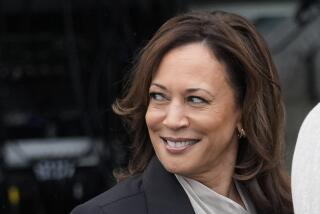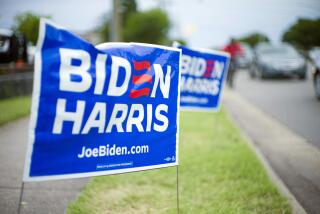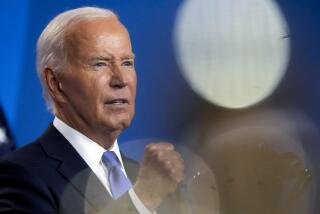It’s now Clinton vs. Clinton and Bush vs. Bush : Campaign: Voters had better fasten their seat belts, because all the candidates have remarkably high negative poll ratings. It’s demolition derby.
WASHINGTON — The presidential race now boils down to two contests--Clinton vs. Clinton and Bush vs. Bush. Each candidate is trying to overcome his own negatives. For Bush, that means criticisms of his record. For Clinton, that means questions about his character.
Politicos are watching for two kinds of news stories: Is there really an economic recovery, and will it be strong enough to save George Bush? And what additional revelations are going to come out about Bill Clinton? Alleged affairs? Financial indiscretions? Draft records? His wife’s business dealings? As a Democratic senator said last week, “People (in Congress) feel we’re all clinging to Clinton’s barrel and it’s about to go over Niagara Falls.”
The big news story last week, however, was one nobody expected. Former Massachusetts Sen. Paul E. Tsongas, Clinton’s closest rival for the nomination, suspended his campaign Thursday. That leaves Clinton as the presumptive nominee. Of course, Edmund G. (Jerry) Brown Jr. is still in the race, but, like Patrick J. Buchanan on the Republican side, Brown is far behind in delegates and likely to have mostly nuisance value. Brown and Buchanan are leaders of political movements. For them, the presidential campaign is just part of a larger agenda.
Tsongas’ withdrawal was surprising. He was poised to win the Connecticut primary Tuesday and had a least a fighting chance in New York on April 7. But he could see the handwriting on the wall. The only way he was going to win the nomination was if Clinton self-destructed. That’s why Tsongas’ withdrawal might have been a smart move. Suppose another scandal emerges and blows Clinton out of the race. Tsongas looks a lot better now than he would if he continued losing primaries. Unlike New York Gov. Mario M. Cuomo, Albert Gore Jr., Rep. Richard A. Gephardt of Missouri and other dark horses, Tsongas actually took the trouble to enter the race.
For all the talk about Tsongas’ lack of charisma, his fatal weakness was that not enough hard-core Democrats liked his message. In primary after primary, Tsongas carried affluent suburban voters and Independents. Clinton got blue-collar whites, minorities, union members and partisan Democrats. That’s the Democratic Party’s base.
Tsongas said, “I am not running to be Santa Claus.” But Santa Claus did not show up in Michigan last Christmas, and a lot of voters, deeply hurt by the recession, are still waiting for him.
Tsongas’ departure will liberate Clinton in one respect. If Cuomo had run for President, Clinton would have been Gary Hart, the candidate who had “new ideas” to bring about economic growth. Instead, after Tsongas won the New Hampshire primary, Clinton was thrust into the role of Walter F. Mondale, the fairness candidate.
Clinton is not an Old Politics Democrat, however. The candidate who came closest to that message in 1992 was Iowa Sen. Tom Harkin. He was the last New Dealer. None of the other Democrats defended the party’s traditional message of big government and big labor.
Until last year, Clinton was chairman of the Democratic Leadership Council (DLC), an organization formed to repudiate Mondale’s discredited interest-group liberalism and move the Democrats back to the center. (Jesse Jackson once called the DLC, “Democrats for the Leisure Class.”) Clinton’s message, like that of Tsongas, is aimed squarely at the suburban middle class. He doesn’t say he favors fairness over growth. He says he believes we can have both at the same time--bridging the gap between Old Politics (fairness) and New Politics (growth).
Clinton brings some impressive strengths to the Democratic ticket. He has the one thing voters are not getting from Bush that they want--a lot of smart new policy ideas about how to turn the economy around. He is a tireless and effective campaigner. Through sheer force of will, he has refused to be thrown on the defensive by one scandal after another. It was remarkable the way Clinton just picked himself up, dusted himself off and kept on fighting.
Clinton’s Southern roots are also helpful. But not because he will sweep the South the way Jimmy Carter did in 1976. What Clinton’s Southernism does is send a signal to moderate and conservative Democrats across the country: He is not another conventional liberal, and his values are not outside the mainstream.
That will help Clinton get votes from Reagan Democrats in states like Illinois and Michigan. They are the white working-class voters who have been voting Republican in presidential elections and thought Michael S. Dukakis was from Mars. Clinton doesn’t pander to those voters. His message of “racial healing” challenges them. But with Clinton, as with Carter, it goes down easier because he is a Southerner.
The Arkansas governor’s success in the primaries suggests the “character issue” didn’t matter to voters. That is not true. Clinton was surging in New Hampshire when allegations about marital infidelity and draft evasion put a halt to his momentum. In the most intensely fought battle of the 1992 campaign so far, Clinton lost to Tsongas in New Hampshire.
True, Clinton swept the South on Super Tuesday and then two major industrial states--Illinois and Michigan--on Tuesday. But his opponents were not exactly major national figures. One political consultant, commenting on the weakness of the Democratic field this year, likened Clinton to “a pine tree in the desert.”
Primary voters are far more partisan than general election voters. The polls suggest that they were also more forgiving of Clinton. Over the past month, as Clinton was consolidating his support among primary voters, his negatives were rising in the larger electorate. In a national CNN/USA Today survey taken after Super Tuesday, one-quarter of all registered voters said they were unlikely to vote for Clinton “because of questions about his character.” Most of them were not Republicans.
While primary voters were settling on Clinton, Democrats who said they wished someone else were running for President increased from 45% in February to 56% in March. And the proportion who thought Bush was likely to win in November jumped from 39% to 57%.
These figures suggest a good deal of wariness toward Clinton among Democrats. Does that mean he is doomed in November? Not necessarily. The same poll suggests a good deal of wariness toward Bush. More than one-third of the voters said they were unlikely to vote for Bush “because he doesn’t stand for anything.” The President’s job rating sank to 40%. And a trial heat between Bush and Clinton showed a very close race.
Right now, Clinton is like Ronald Reagan was in 1980. He has some powerful negatives but, barring any spectacular new revelations, he should not be considered unelectable. In 1980, the voters were afraid of Ronald Reagan. They saw him as a right-wing extremist who might start a war or throw old people out in the snow. But things were so bad under Carter that the voters decided they had to have change. They couldn’t keep going the way they were going. So they took a chance and elected Reagan.
Right now, Clinton’s negatives are high (37%). But Bush’s are just as high (39%). If people want change badly enough--as badly as they did in 1980--they will vote for Clinton. Clinton knows that, which is why he refers to himself, again and again, as the candidate of change.
What we are left with is two candidates with high negatives (Bush and Clinton), two candidates with higher negatives (Brown and Buchanan)--and more than seven months to go in the campaign. Who’s going to win? The last candidate standing after all the others have destroyed themselves. It’s going to be the longest demolition derby in history.
More to Read
Get the L.A. Times Politics newsletter
Deeply reported insights into legislation, politics and policy from Sacramento, Washington and beyond. In your inbox three times per week.
You may occasionally receive promotional content from the Los Angeles Times.










